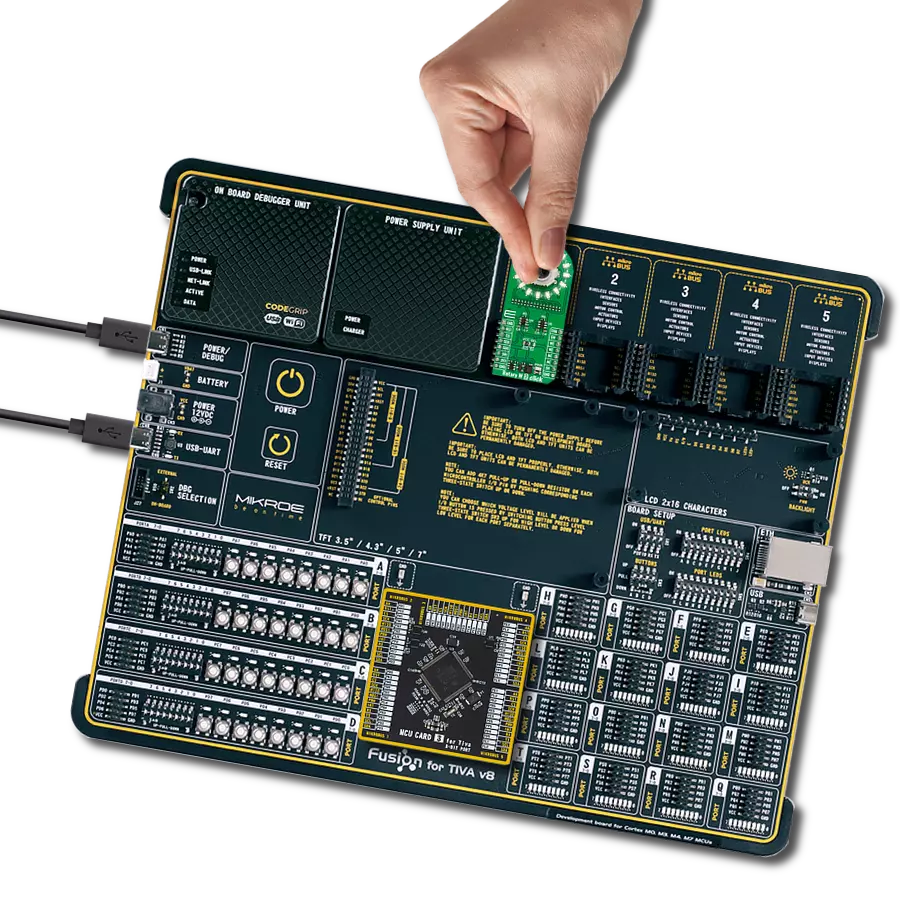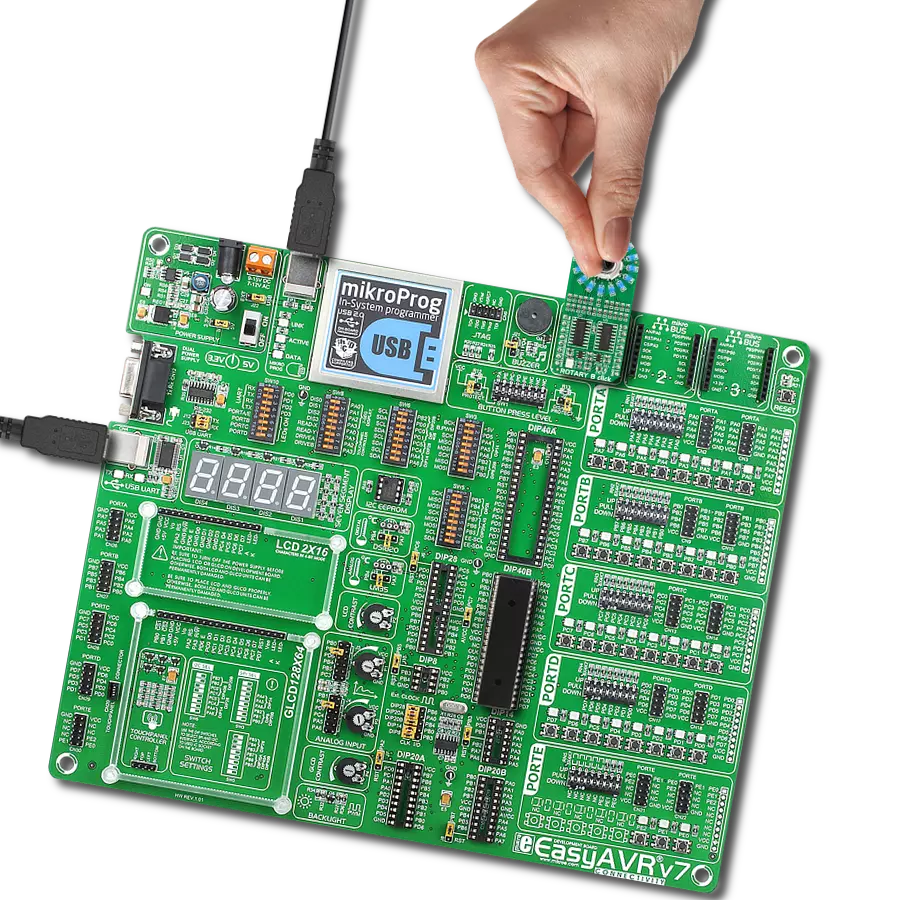体验一种先进的四象限计数器,旨在通过准确的运动测量提升您的设计水平。
A
A
硬件概览
它是如何工作的?
Counter Click基于LSI计算机系统的LS7366R,这是一个带有串行接口的32位正交计数器。它是一个CMOS计数器,具有直接接口,用于从增量编码器获取正交时钟。它还与增量编码器的索引信号进行接口,以执行各种标记功能。该计数器可以配置为1、2、3或4字节计数器。它还可以编程为在几种计数模式下工作,例如Modulo-N、非循环、范围限制或自由运行模式。这个Click板™具有一个2x5引脚排(2.54mm间距),用于接口LS7366R的输入、VCC和一些GND,基本
上是Click板™本身的电源引脚。VCC和GND引脚可以为正交增量 编码器供电。这个标头还包括ENCA和ENCB,即LS7366R的输入A和B引脚,直接将增量编码器的正交时钟输出应用于它们,并且索引(ENCI)引脚,这是由增量编码器的索引输出直接驱动的可编程输入。LS7366R使用标准的4线SPI串行接口通过mikroBUS™插座与主机MCU进行通信。当EN输入处于高逻辑状态时,计数器被启用;否则,它以低逻辑电平被禁用。此外,这个Click板™还具有通过INT引脚的中断功
能,可以通过LF和DF焊接跳线来配置使用LFLAG或DFLAG,DFLAG默认设置。这样,用户可以选择LFLAG,即开漏锁定输出,或DFLAG,即瞬态推挽输出,从而使用这些输出来标志Carry、Borrow、Compare和Index发生。这个Click板™可以通过PWR SEL跳线选择3.3V或5V逻辑电压电平进行操作。这样,3.3V和5V兼容的MCU都可以正确地使用通信线。此外,这个Click板™配备了一个包含易于使用的函数和示例代码的库,可用作进一步开发的参考。
功能概述
开发板
Nucleo 32开发板搭载STM32F031K6 MCU,提供了一种经济且灵活的平台,适用于使用32引脚封装的STM32微控制器进行实验。该开发板具有Arduino™ Nano连接性,便于通过专用扩展板进行功能扩展,并且支持mbed,使其能够无缝集成在线资源。板载集成
ST-LINK/V2-1调试器/编程器,支持通过USB重新枚举,提供三种接口:虚拟串口(Virtual Com port)、大容量存储和调试端口。该开发板的电源供应灵活,可通过USB VBUS或外部电源供电。此外,还配备了三个LED指示灯(LD1用于USB通信,LD2用于电源
指示,LD3为用户可控LED)和一个复位按钮。STM32 Nucleo-32开发板支持多种集成开发环境(IDEs),如IAR™、Keil®和基于GCC的IDE(如AC6 SW4STM32),使其成为开发人员的多功能工具。

微控制器概述
MCU卡片 / MCU

建筑
ARM Cortex-M0
MCU 内存 (KB)
32
硅供应商
STMicroelectronics
引脚数
32
RAM (字节)
4096
你完善了我!
配件
Click Shield for Nucleo-32是扩展您的开发板功能的理想选择,专为STM32 Nucleo-32引脚布局设计。Click Shield for Nucleo-32提供了两个mikroBUS™插座,可以添加来自我们不断增长的Click板™系列中的任何功能。从传感器和WiFi收发器到电机控制和音频放大器,我们应有尽有。Click Shield for Nucleo-32与STM32 Nucleo-32开发板兼容,为用户提供了一种经济且灵活的方式,使用任何STM32微控制器快速创建原型,并尝试各种性能、功耗和功能的组合。STM32 Nucleo-32开发板无需任何独立的探针,因为它集成了ST-LINK/V2-1调试器/编程器,并随附STM32全面的软件HAL库和各种打包的软件示例。这个开发平台为用户提供了一种简便且通用的方式,将STM32 Nucleo-32兼容开发板与他们喜欢的Click板™结合,应用于即将开展的项目中。
使用的MCU引脚
mikroBUS™映射器
“仔细看看!”
Click board™ 原理图

一步一步来
项目组装
实时跟踪您的结果
应用程序输出
1. 应用程序输出 - 在调试模式下,“应用程序输出”窗口支持实时数据监控,直接提供执行结果的可视化。请按照提供的教程正确配置环境,以确保数据正确显示。

2. UART 终端 - 使用UART Terminal通过USB to UART converter监视数据传输,实现Click board™与开发系统之间的直接通信。请根据项目需求配置波特率和其他串行设置,以确保正常运行。有关分步设置说明,请参考提供的教程。

3. Plot 输出 - Plot功能提供了一种强大的方式来可视化实时传感器数据,使趋势分析、调试和多个数据点的对比变得更加直观。要正确设置,请按照提供的教程,其中包含使用Plot功能显示Click board™读数的分步示例。在代码中使用Plot功能时,请使用以下函数:plot(insert_graph_name, variable_name);。这是一个通用格式,用户需要将“insert_graph_name”替换为实际图表名称,并将“variable_name”替换为要显示的参数。

软件支持
库描述
这个库包含Counter Click驱动程序的API。
关键函数:
counter_read_cntr- 使用click对象读取CNTR。counter_read_str- 使用click对象读取STR。counter_read_otr- 使用click对象读取OTR。
开源
代码示例
完整的应用程序代码和一个现成的项目可以通过NECTO Studio包管理器直接安装到NECTO Studio。 应用程序代码也可以在MIKROE的GitHub账户中找到。
/*!
* \file
* \brief Counter Click example
*
* # Description
* This application measures the speed and the position of the DC motor shafts.
*
* The demo application is composed of two sections :
*
* ## Application Init
* Initializes driver and configures the click board.
*
* ## Application Task
* Reads data from the CNTR register and calculates the speed of the motor in Rad/s.
* All data is being displayed on the USB UART terminal where you can track their changes.
* The CNTR is a software configurable 8, 16, 24 or 32-bit up/down counter which
* counts the up/down pulses resulting from the quadrature clocks applied at the
* A and B inputs, or alternatively, in non-quadrature mode, pulses applied at the A input.
*
* ## NOTE
* An appropriate motor with optical encoder needs to be connected to the click board.
*
* \author MikroE Team
*
*/
// ------------------------------------------------------------------- INCLUDES
#include "board.h"
#include "log.h"
#include "counter.h"
// ------------------------------------------------------------------ VARIABLES
static counter_t counter;
static log_t logger;
static int32_t count;
static int32_t count_old;
static float speed;
// ------------------------------------------------------ APPLICATION FUNCTIONS
void application_init ( void )
{
log_cfg_t log_cfg;
counter_cfg_t cfg;
/**
* Logger initialization.
* Default baud rate: 115200
* Default log level: LOG_LEVEL_DEBUG
* @note If USB_UART_RX and USB_UART_TX
* are defined as HAL_PIN_NC, you will
* need to define them manually for log to work.
* See @b LOG_MAP_USB_UART macro definition for detailed explanation.
*/
LOG_MAP_USB_UART( log_cfg );
log_init( &logger, &log_cfg );
log_info( &logger, "---- Application Init ----" );
// Click initialization.
counter_cfg_setup( &cfg );
COUNTER_MAP_MIKROBUS( cfg, MIKROBUS_1 );
counter_init( &counter, &cfg );
counter_default_cfg( &counter );
Delay_ms( 300 );
}
void application_task ( void )
{
count = counter_read_cntr( &counter );
log_printf( &logger, "Counter: %ld\r\n", count );
speed = ( float ) ( count - count_old ) / 3600.0;
speed *= 6.283185;
log_printf( &logger, "Speed: %.4f Rad/s\r\n", speed );
count_old = count;
log_printf( &logger, "-------------------------\r\n" );
Delay_ms( 1000 );
}
void main ( void )
{
application_init( );
for ( ; ; )
{
application_task( );
}
}
// ------------------------------------------------------------------------ END
额外支持
资源
类别:旋转编码器

































